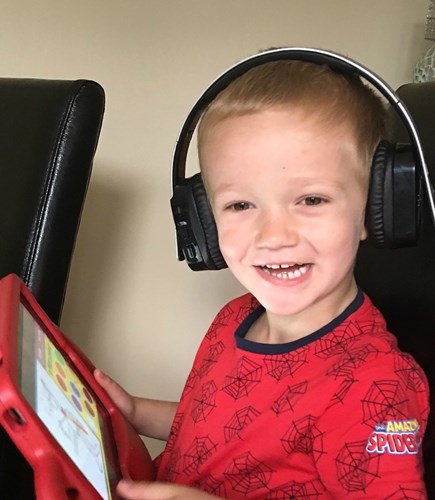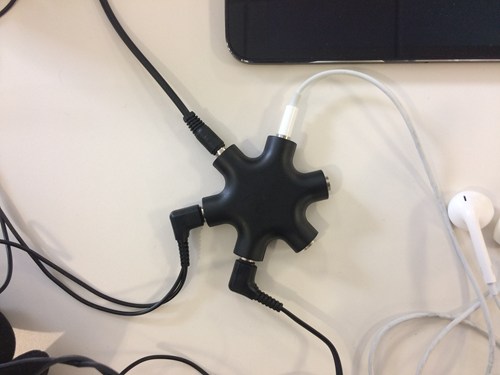Enjoying TV as a family
Christmas is often a time of family gatherings and watching classic Christmas films together, but this can be difficult if your child can’t hear the TV as well as everyone else. Here we discuss some tips and tricks that may be useful for enjoying TV as a family.
There are various solutions that can help your deaf child to hear the TV better without everyone else having to listen with the volume turned up high. But some of these solutions may not be practical or suitable for family TV time.
For example, at home you may have a room loop which is a fixed and popular solution if your child has a hearing aid or implant with the T setting. But a room loop isn’t easy to install quickly when your child celebrates Christmas at their grandparents’ house. Or your child may watch TV using wired headphones – but wires on the living room floor during large family gatherings may create a trip
hazard. Or perhaps your child likes watching films on a tablet, but connecting a product that helps them hear better may mean the sound is cut off for others, which hinders watching together.
Families told us they struggle with these issues, so here are some solutions to help the whole family watch films in a comfortable way.
Amplified headphones with Bluetooth connectivity work with any audio device that has Bluetooth, such as laptops, tablets or smartphones. Even some modern TVs have Bluetooth connectivity. The big advantage of Bluetooth headphones is that they are 100% cordless. This means your child can move around freely and sit where they want and there’s less risk of family members tripping over wires.

“We borrowed Bluetooth headphones from the National Deaf Children’s Society Technology Test Drive Service. They are easy to carry around and fold flat. We’ve since bought a pair and my son loves them. As part of his daily routine he spends dedicated time watching his iPad and the headphones have helped with his speech and learning new words. He likes watching Arthur Christmas and the BBC’s Christmas animation of Stick Man and this has helped him when we read the story as he knows most of it.”
Suzanne, who borrowed the Geemarc CL7400BT headphones for her son Jack (4) who is moderately deaf.

The downside is that pairing Bluetooth headphones with an audio device often means the sound through the normal speakers is cut off for everyone else. A Bluetooth splitter may provide a solution. It can send sound to multiple Bluetooth receivers such as Bluetooth headphones or Bluetooth speakers. We tried the Kokkia iSplitter and watched programmes on a tablet using a Bluetooth neckloop and Bluetooth headphones at the same time: perfect for deaf and hearing family members to enjoy TV together!
If you like the idea of headphones but your TV doesn’t have Bluetooth, you may like amplified wireless headphones with a transmitter. The transmitter unit plugs into the TV or other audio source and sends sound wirelessly to the headphones. Similarly to the Bluetooth headphones, your child will have complete freedom of movement. Multiple headsets can be connected to the same transmitter so you can listen to films together.

“We attended the National Deaf Children’s Society Roadshow and wanted to try some of the products we saw at home. We borrowed headphones with a TV transmitter. They’re loud and clear, and easy to set up and use. My daughter loved this product and we have now purchased it.”
Leanne, who borrowed the Geemarc CL7400 cordless headphones for her daughter Eva (9) who is profoundly deaf.
TV listeners are another portable solution that work via a transmitter unit that plugs into the TV. The transmitter sends sound to a receiver your child can wear around their neck or place in front of them. If the TV listener is connected to the TV’s SCART socket, it shouldn’t cut off the TV’s speaker sound so the rest of the family can hear it too. TV listeners can also be connected to other audio devices such as laptops and tablets.
Streamers can easily be carried around. They wirelessly link a child’s hearing aids or cochlear implants to a range of audio devices, including smartphones, laptops, and tablets. Because they send sound directly to your child’s hearing devices you have to use a streamer from the same manufacturer. Accessories such as TV adapters are available for most streamers. TV adapters are small boxes which can be plugged into the TV with a SCART cable, which again means your child can wirelessly listen to the TV at the same time as the rest of the family.

“We borrowed a streamer to alleviate the problem of our son missing bits of films when watching as a family. It was very easy to install, made the TV louder and clearer for him. It helped him pick up everything that was going on in the film and helped us watch as a family without friction! It was something that made an immediate and practical difference to everyday life.”
Heidi, who borrowed the Oticon Streamer Pro 1.3A for her son Charlie (10) who is moderately deaf.

And if wireless solutions don’t suit you, there are several wired headphones available. Headphone splitters only cost a couple of pounds and can be bought at most electronics stores. They allow two or more headphones or speakers to be used at the same time. Just don’t trip over the wires!
